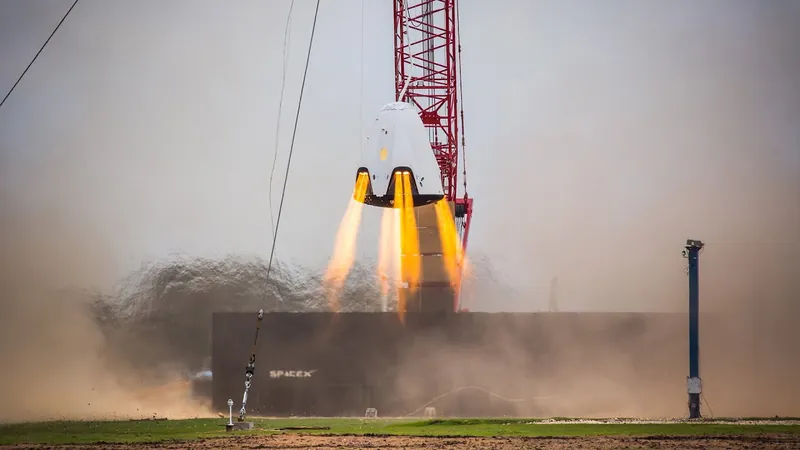
SpaceX Revives Propulsive Landing Technology for Dragon Spacecraft: A Game-Changer for Space Travel!
2024-10-10
Author: Wei Ling
SpaceX has made a groundbreaking announcement regarding its Dragon spacecraft on September 27, showcasing a major upgrade to ensure the safety and reliability of crewed missions. The company has introduced a propulsive landing capability, allowing the Dragon to use its SuperDraco thrusters as a backup in the unlikely event of a parachute failure. This innovation could significantly enhance the safety of astronauts returning to Earth from space.
The concept of propulsive landing was initially revealed by SpaceX over ten years ago. When the Dragon 2 was introduced, it was heralded as being able to execute a propulsive landing anywhere on the planet. However, due to various technical and safety concerns, SpaceX opted for parachutes as the primary recovery method for Dragon 2 missions.
The Evolution of Dragon's Design
The development of Dragon 2 has been a lengthy process, with numerous changes made since its unveiling on May 30, 2014, transforming it into the trusted crewed spacecraft it is recognized as today. What was once deemed an abandoned concept—propulsive landings—has been resurrected as SpaceX now integrates this crucial safety feature back into its operations.
But what exactly makes propulsive landings advantageous?
Benefits of Propulsive Landings
1. Enhanced Reusability: By landing on solid ground instead of water, SpaceX can reduce the wear and tear on Dragon’s hardware. Saltwater can cause severe corrosion, delaying refurbishment and re-launch times. If Dragon lands on designated landing pads, the potential for damage decreases, making it a prime candidate for rapid reusability.
2. Faster Crew Recovery: Traditional ocean landings can complicate the recovery of astronauts due to waves, making it a lengthy process. A solid ground landing can streamline the extraction of crew members, which is vital after prolonged exposure to microgravity.
3. Mars Mission Readiness: Originally, SpaceX envisioned using propulsive landings for missions to Mars, where parachutes are less effective due to the planet's thin atmosphere. Though the Red Dragon initiative was eventually shelved in favor of the ambitious Starship program, the need for effective ground landings persists in future Mars missions.
Challenges Faced in Propulsive Landing Development
Despite its initial promise, the propulsive landing capability faced numerous hurdles. Certifying spacecraft for flight is a rigorous process, which hindered plans for the Red Dragon mission. Challenges were exacerbated after NASA's refusal to fund the Red Dragon concept, prompting SpaceX to focus on enhancing Dragon 2 for Earth missions instead.
After successful test flights, the plans for integrating a propulsive landing system appeared to stall, partly due to an incident involving Crew Dragon C204 that resulted in a total loss of the vehicle during a SuperDraco testing phase. This raised doubts about the feasibility of propulsive landings, temporarily pushing the concept into the background.
A New Dawn for Dragon’s Propulsive Landing Capability
Fast forward to today, and the Crew Dragon spacecraft has proven itself through numerous successful missions to the International Space Station (ISS) and beyond.NASA recently confirmed that the Dragon spacecraft can now activate its SuperDraco engines as a backup for parachute landings. Should there be any parachute issues during re-entry, Dragon can make a controlled splashdown using its thrusters instead.
The excitement doesn’t stop there—during the Crew-9 post-launch press conference, SpaceX officials revealed that this propulsive landing capability will remain active for upcoming missions, ensuring that the safety of astronauts remains a top priority.
In a future where space travel is becoming increasingly common, SpaceX’s determination to enhance the safety and reliability of the Dragon spacecraft through propulsive landing technology represents a significant step towards revolutionizing space exploration. Could we be looking at the future of landing technologies that may very well pave the way for Mars exploration and beyond? Only time will tell!
Keep an eye on SpaceX as they continue to push the boundaries of innovation and redefine our understanding of safe space travel.



 Brasil (PT)
Brasil (PT)
 Canada (EN)
Canada (EN)
 Chile (ES)
Chile (ES)
 España (ES)
España (ES)
 France (FR)
France (FR)
 Hong Kong (EN)
Hong Kong (EN)
 Italia (IT)
Italia (IT)
 日本 (JA)
日本 (JA)
 Magyarország (HU)
Magyarország (HU)
 Norge (NO)
Norge (NO)
 Polska (PL)
Polska (PL)
 Schweiz (DE)
Schweiz (DE)
 Singapore (EN)
Singapore (EN)
 Sverige (SV)
Sverige (SV)
 Suomi (FI)
Suomi (FI)
 Türkiye (TR)
Türkiye (TR)